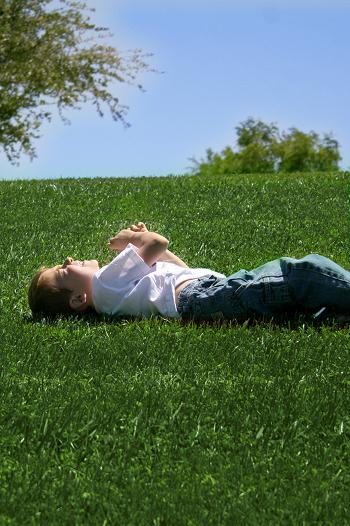Rolling down the hill
Duration/age

Children often experiment with moving their bodies in different ways. They might move in time to music or try and fit their bodies inside different spaces. Sometimes they will try and figure out how to move without using their legs and feet.
Next time you are near a hill encourage your child to experiment with different ways to roll down the hill. Can they tuck their bodies into a tight ball and roll? Can they become long and sausage-like, putting their arms above their head as they roll?
Talk with your child about the different ways they can roll. Is there more than one way to place your arms, head or legs? Does placing your arms or legs in different positions make the rolling faster or slower?
Try and find lots of different hills for rolling down. Do you roll faster or slower on a steep hill? Does it make a difference if the hill is made of sand compared to grass?
The grass is much faster to roll down than the sand.
I can roll sideways down the hill when the sand is hard. When it is soft it is too hard to turn my body over.
Materials you will need
- Your body
- A hill
Skills this activity improves
Why does this matter?
Regular physical activity when your child is very young can have a positive impact on their immediate and long term health.
Physical activity helps children to develop their senses, posture, strength and balance. As they move about they are using all of their body. Whole body movement will include their upper body, lower body and will help with trunk stability.
As they move around in the natural environment or experiment with different ways to roll, they are developing language to communicate what they are doing and they are listening to directions. As you talk about where to place their arms, head or legs they are hearing and following positional and directional language.
As your child rolls down different sized hills with different gradients they are experimenting with measurement and the different language we can use to describe measurement. Measurement can be described as how long or fast it takes to do something, or by number - “I did 10 rolls”.
What does this lead to?
Encouraging your child to move and roll differently helps them to understand that they can use and move their bodies in many ways. As they explore the different ways their bodies move they are learning about measurement, space and size and how to move within and around objects.
As your child moves they’re using all of their body and senses. They are developing strength, control and coordination in all of their body parts including the large muscles in their trunk. Having a strong core, or trunk, is important as it helps children with good sitting posture. Having a good sitting posture is important for writing and completing table tasks.
Language to use
- Hill, slope
- Up, down
- Big, little, medium, small
- Gradient, steep, gentle, slope
- Grass, sand
- Bumpy, smooth
- Above, against
- Arms, leg, head, body
- Tuck, curl, lengthen
- Back, front, side, tummy
- Forward, backwards
Questions to use
- Is it faster to roll tucked up as a ball or long and straight like an arrow?
- Do you roll straight if the ground is bumpy?
- Do bigger bodies roll faster than smaller bodies?
Useful tips
- You might also like to take a look at the activities Let's get physical, Baby obstacle course and Up, over, under, through.
- See 49 things to do before you're 5 for more ideas about being active and physical outside.
- For more information on your child's physical development see the Child Health Record - the Blue Book.
- The Department of Health also has some hints and tips about physical activity for children aged 0 to 5.
- Remember to talk to your child in your home language.
More ideas
- Practice rolling on a flat surface or a mat.
- Sing the song 10 in the bed. Get your child to use their bodies to act out the song.
Variation by age
Birth to two year olds
- Play Twister or Simon Says.
- Sing songs that get your child to use different parts of their body.
- Make your own obstacle course from found objects.
- Experiment with rolling other objects down the hill.
Three to five year olds
- Play Twister or Simon Says.
- Sing songs that get your child to use different parts of their body.
- Make your own obstacle course from found objects.
- Experiment with rolling other objects down the hill. Time which objects are fastest or slowest getting down the hill.
Language to use
- Top, bottom
- Fast, slow, quick
- Under, over
- Arm, leg, head, body, tummy
- Front, side, back
Language to use
- Top, bottom
- Fast, slow, quick
- Under, over
- Arm, leg, head, body, tummy
- Front, side, back


